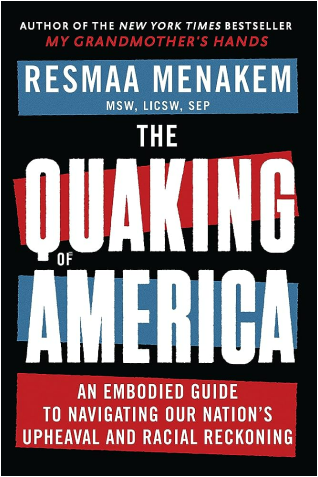White fragility has bonded with its dangerous half-sibling.
KEY POINTS:
- Ferality has always been with us—but so have empathy, cooperation, generosity, kindness, and love.
- Ferality flows, ebbs, and flows again. Sadly, it currently flows freely in much of the world.
- For the past 500 years, one particular form of ferality—racialized ferality or white ferality—has been part of life in what is now the Americas.
- White ferality now often appears alongside white fragility, with the two braided into a toxic (and sometimes deadly) double helix.
- Today, in Orwellian fashion, high-emotion media—especially right-wing network television and social media—attempt to turn perpetrators into perceived victims, and white ferality into a patriotic virtue.
We live in a time of spreading ferality.
We see it regularly in headlines, in news feeds, and on social media. Most of all, we experience it daily in our bodies.
Each day, new waves of ferality wash over us. In rampage after rampage, American men shoot multiple strangers. In attack after attack, Putin murders unarmed civilians, often targeting children. Xi rounds up innocent Chinese citizens, forcing some to pick cotton in concentration camps and sending others to prison for expressing an opinion. In Myanmar, a brutal military dictatorship massacres its own citizens. In Afghanistan, the Taliban promises people forgiveness or amnesty, then executes them. As I worked on this blog post, Boko Haram gunmen stormed a Nigerian church during services, killing at least 50 people, many of them children. Here in the States, GOP candidates and other key Republican figures encourage murder, mayhem, and autocracy, and eagerly trumpet their plans to replace justice with brute force.

Ferality has always been with us. It is part of our nature as human beings—a nature that also includes empathy, cooperation, generosity, kindness, and love. The very definition of civilization is the practice of collectively reining in our ferality and nurturing our better natures.
Over the centuries, ferality has flowed, ebbed, and flowed again. Sadly, it currently flows freely throughout much of the world.
In the realm of human ferality, there are no such things as alternate viewpoints, disagreements, or conflicts. There are only enemies—others—who must be dominated, subjugated, or destroyed. There are two acceptable tools for achieving this goal: violence and the threat of violence. The apparatus for delivering this violence may be as simple as a handgun or a sword, or as complex as a police force, court of law, or national legislature.
One particular form of ferality, racialized ferality, has been present in my part of the world for over 500 years. When Spanish and Portuguese armies arrived in the Indigenous ancestral homelands that we now call the Americas, this was their message: We’re powerful white bodies with guns, cannons, swords, crossbows, and halberds. We’re destroying your civilizations and taking and controlling everything. It’s now private property. Obey us or we’ll kill you. Sometimes we’ll kill you anyway, you things.
That message took root among many generations of later European immigrants and their descendants. It has manifested itself in a variety of feral (and legal) forms; these include genocide, enslavement, lynch mobs, internment camps, American Indian boarding schools, the Chinese Exclusion Act, fugitive slave patrols, modern police unions, and a long list of others. As Ta-Nehisi Coates has observed, this message “dislodges brains, blocks airways, rips muscle, extracts organs, cracks bones, breaks teeth….” And it has done so—structurally, consistently, and persistently—for centuries.
A second stream of racialized ferality has been passed down from a different direction. Beginning in the late Middle Ages, the Puritans and other groups of Europeans fled to the New World to avoid the ferality of other, more powerful white bodies. As I wrote In My Grandmother’s Hands:
In England, the 1500s and 1600s were not gentle times. People were routinely burned at the stake for heresy—a practice that began in the twelfth century and continued through 1612. Torture was an official instrument of the English government until 1640….Many of the English who colonized America had been brutalized, or had witnessed great brutality first-hand. Others were the children and grandchildren of people who had experienced such savagery in England….
When the English came to America, they brought much of their resilience, much of their brutality—and, I believe, a great deal of their trauma—with them. Common punishments in the New World English colonies included whipping, branding, and the cutting off of ears. People were routinely placed in stocks or pillories—or in the gallows with a rope around their neck….The Puritans also regularly murdered people who were disobedient, or found guilty of witchery. In 1692, during the Salem witch trials, eighty-year-old Giles Corey was stripped naked and, over a period of two days, slowly crushed to death under a pile of rocks….
Well before the United States began, white American and English bodies oppressed, brutalized, and murdered other, less powerful white ones. The centuries-old (and ongoing) ferality perpetrated on bodies of culture in America began as an adaptation of longstanding white-body-on-white-body ferality.
A recent mutation of white ferality now often appears alongside white fragility, with the two braided into a toxic (and sometimes deadly) double helix.
The term white fragility was coined by my colleague Robin DiAngelo, who first used it in print in a 2011 article in The International Journal of Critical Pedagogy, then in her bestselling 2018 book White Fragility. DiAngelo defines white fragility as
a state in which even a minimum amount of racial stress becomes intolerable, triggering a range of defensive moves. These moves include the outward display of emotions such as anger, fear, and guilt, and behaviors such as argumentation, silence, and leaving the stress-inducing situation. These behaviors, in turn, function to reinstate white racial equilibrium….
(This quotation is from the 2011 article, which is available as a free DF at http://libjournal.uncg.edu/ijcp/article/view/249/116. If you have not yet read DiAngelo’s article or book, I strongly urge you to.)
Increasingly in recent years, some white-bodied Americans—from the Buffalo mass shooting suspect to Arizona GOP state senator Wendy Rogers—have responded to small amounts of racial stress not with DiAngelo’s “range of defensive moves,” but with a wide range of feral, highly aggressive, and sometimes deadly ones. (Speaking at a white nationalists’ conference in Orlando in February 2022, Rogers said, “We need to build more gallows,” in order to “make an example of these traitors who’ve betrayed our country.”)
Here is one of the most successful ways in which many far-right political candidates and media figures currently encourage the spread of this white ferality:
- Create a bogus racialized emergency—in this case, White Replacement Theory. This imaginary conspiracy claims that Democrats—or Jews, or other citizens who aren’t white Christians—are trying to bring in millions of brown-bodied people. Their ostensible goal is to replace white-bodied ones, and to thereby permanently install socialism in America (and perhaps also confiscate all firearms).
- Claim that, through this process, white-bodied people are being widely, deeply, profoundly, and relentlessly victimized.
- Announce that, unless this emergency is addressed, “America” or “the American way of life” will die.
- Insist (or strongly imply) that the only effective response to White Replacement Theory is to “take your country back” through violence.
- Through multiple high-emotion media—especially social media and right-wing network television—spread this set of lies, glorify violence, and attempt to activate feral impulses in ever more white bodies, in what has now become a worldwide feedback loop.
I call this sleight-of-hand perping from a false bottom. In Orwellian fashion, it attempts to turn perpetrators into perceived victims—and white ferality into a patriotic virtue. But, like all other forms of white-body supremacy, it’s a con, a scam, a dodge, and a fraud. Also like all other forms of white-body supremacy, it has centuries-old historical roots. Here is one example of many: White Replacement Theory has parallels with the Lost Cause narrative, an entirely false description of the American Civil War that paints the South as a just, noble, and genteel society that was cruelly victimized by the North. Today, the Lost Cause myth continues to be used to recruit white bodies to commit insurrection and other forms of ferality.
White fragility has long been a facet of American life. Now it has once again bonded with its dangerous half-sibling, white ferality. Please watch your back. We also need to watch each other’s.
BODY PRACTICE: ORIENTING FOR SAFETY
Your body is always interacting with the space and energies surrounding it. Orienting your body to these can help you build its capacity for resource and discernment. Regularly orienting your body can also help keep it safe.
Go to a safe and fairly busy public place, such as a train station, airport, park, office building lobby, or shopping mall. Find a spot where you can stand or sit quietly for a few minutes without being in anyone’s way.
Begin by taking a few long, slow breaths. Then, breathing normally, slowly turn your head and notice your surroundings. Look first to one side, then the other. Then swivel your shoulders and your head to each side, so that you can look behind you in each direction. Then look up, then down.
As you observe your surroundings, answer these questions:
- Where are all the exits or paths leading away?
- What structures or objects will you need to move around in order to leave?
- Where are all the spots through which people can approach you?
- In the event of danger, what spots nearby may provide your body with protection?
Now turn your attention back to your body—but also remain aware of your location. Ask yourself these questions:
- In the event of any danger, what parts of your body will be most vulnerable?
- What can you do to quickly protect those parts of your body? (This might involve crouching, lying prone, or moving behind a structure or corner.)
Do a very quick body scan. What parts of your body are reacting most strongly? Where do you experience constriction, or fear, or dread, or stuckness, or heat, or any other strong response?
Throughout this body practice, notice what your body experiences. Pay attention to what you experience in:
- Vibrations
- Images and thoughts
- Meanings, judgments, stories, and explanations
- Behaviors, movements, actions, impulses, and urges
- Affect and emotions
- Sensations
- Imagination
If you like, write down some or all of what your body experiences.
The body practice in this post was adapted from my new book, The Quaking of America: An Embodied Guide to Navigating Our Nation’s Upheaval and Racial Reckoning.

